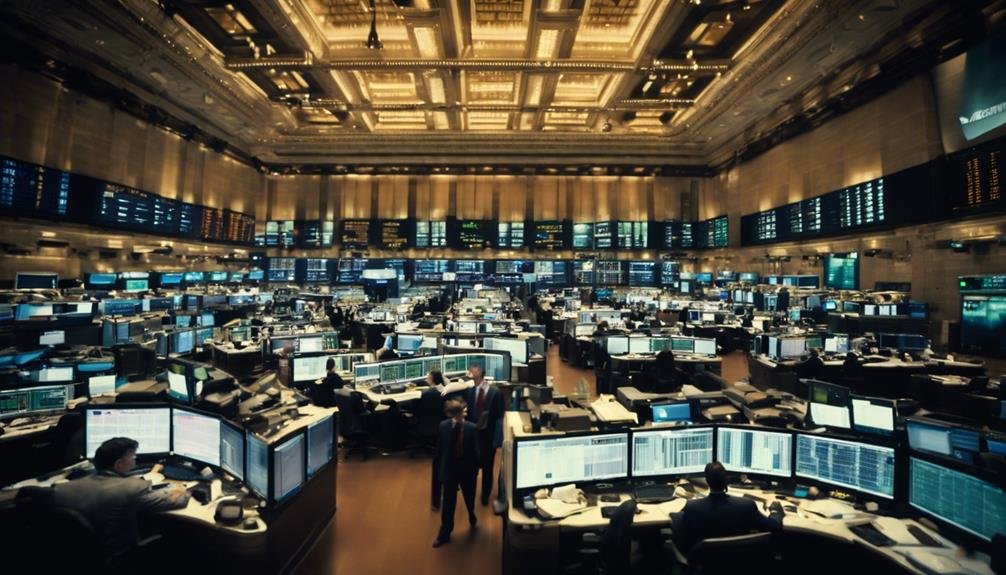The Impact of Technology on Stock Exchanges
Technology revolutionizes stock exchanges by shifting to electronic platforms, boosting efficiency, and reshaping global markets. Automation enhances liquidity and speed, but high-frequency trading raises volatility concerns. Artificial intelligence offers real-time insights for better decisions and market predictions. Blockchain guarantees transparent, secure transactions while complying with regulations faces complexities in automated systems. Oversight benefits from tech advancements for real-time monitoring and compliance. Globalization expands market accessibility, liquidity, and regulatory integration. Future trends point to advanced analytics, algorithmic trading, blockchain, and efficiency gains. Explore how technology's impact on stock exchanges drives innovation and market dynamics.
Key Takeaways
- Evolution to electronic trading platforms for efficiency.
- Automation boosting liquidity and trade execution speed.
- Rise of high-frequency trading impacting market dynamics.
- Artificial intelligence revolutionizing data analytics and decision-making.
- Blockchain enhancing transparency, security, and trade automation.
Evolution of Stock Exchange Platforms
The evolution of stock exchange platforms has been marked by a rapid transformation in response to technological advancements, fundamentally reshaping the way financial instruments are traded. Over the years, stock exchanges have undergone significant evolutionary changes, moving from traditional open outcry systems to electronic trading platforms. Technological advancements have played a pivotal role in this shift, enabling faster execution speeds, improved liquidity, and enhanced market transparency.
One of the key evolutionary changes in stock exchange platforms has been the adoption of electronic communication networks (ECNs) and algorithmic trading. ECNs have revolutionized the trading process by matching buy and sell orders electronically, reducing the need for manual intervention. Algorithmic trading, on the other hand, utilizes complex algorithms to execute large orders at best prices, increasing efficiency and reducing market impact.
Moreover, advancements in data analytics and machine learning have empowered stock exchanges to analyze vast amounts of data in real-time, enabling better risk management and decision-making processes. These technological advancements have not only made trading more efficient but have also increased market accessibility and participation, fostering a more inclusive and dynamic trading environment.
Automation of Trading Processes
Advancements in technology have led stock exchanges to increasingly automate trading processes, revolutionizing the efficiency and speed of executing financial transactions. The integration of algorithmic trading strategies has greatly impacted market liquidity by enhancing trade execution speed and reducing transaction costs. Automated processes enable market participants to execute trades at best prices and quantities, contributing to improved market efficiency. Moreover, automation plays an essential role in risk management by enforcing pre-set risk controls and ensuring compliance with regulatory requirements. By swiftly identifying and reacting to potential risks, automated systems help mitigate market volatility, enhancing overall market stability.
The automation of trading processes has not only increased the scalability of trading operations but has also facilitated a more seamless and transparent market environment. Market participants can leverage advanced technological tools to analyze market data in real-time, identify trading opportunities, and execute trades with precision. As a result, automation has become an indispensable component of modern stock exchanges, shaping the dynamics of financial markets globally.
Rise of High-Frequency Trading
In the domain of contemporary stock exchanges, the proliferation of high-frequency trading has greatly altered the landscape of financial markets. High-frequency trading involves the use of powerful computers to execute trades at incredibly high speeds, often measured in microseconds. This rapid pace of trading has both benefits and drawbacks, impacting market volatility, algorithmic trading, speed, and the potential for market manipulation.
| High-Frequency Trading | Impact on Financial Markets |
|---|---|
| Speed | Enables trades to be executed in microseconds, leading to increased market efficiency. |
| Market Volatility | Can contribute to sudden and drastic price fluctuations due to the high volume of trades being executed. |
| Algorithmic Trading | High-frequency trading relies heavily on complex algorithms to make split-second trading decisions, shaping market dynamics. |
| Market Manipulation | There are concerns about the potential for high-frequency traders to engage in manipulative practices, exploiting speed advantages for profit. |
Impact of Artificial Intelligence
With the integration of artificial intelligence into stock exchanges, a pivotal transformation in market dynamics and decision-making processes is being observed. Artificial intelligence (AI) is revolutionizing stock exchanges through its capabilities in data analytics and machine learning. AI algorithms can analyze vast amounts of data at speeds incomprehensible to humans, enabling real-time insights and more informed decision-making.
Data analytics plays a vital role in extracting valuable insights from the massive volume of data generated in stock exchanges daily. AI algorithms can identify patterns, trends, and anomalies in the data, helping traders and investors make more accurate predictions and strategic decisions. Machine learning, a subset of AI, allows systems to learn from data, improve performance over time, and adapt to changing market conditions autonomously.
Furthermore, AI-powered trading systems can execute trades with precision and efficiency, contributing to increased liquidity and market efficiency. Overall, the integration of artificial intelligence in stock exchanges is enhancing market transparency, efficiency, and the overall trading experience for market participants.
Role of Blockchain Technology
Blockchain technology has revolutionized the financial industry by offering enhanced transparency and security in transactions. Stock exchanges are increasingly adopting blockchain for its decentralized nature, which eliminates the need for intermediaries and reduces transaction costs.
With blockchain, the potential for creating more efficient and trustworthy trading platforms is vast, shaping the future of stock exchanges.
Blockchain for Transparency
The implementation of blockchain technology in stock exchanges has revolutionized transparency in financial transactions. Blockchain's decentralized and immutable nature guarantees that transaction records are securely stored and easily verifiable, offering unparalleled transparency benefits.
By utilizing blockchain, stock exchanges can enhance investor trust through real-time access to transaction data while reducing the risk of fraud and manipulation. The implementation of this technology enables the creation of a tamper-proof ledger that enhances the audit trail, making it easier to track and verify transactions.
Decentralized Trading Platforms
Decentralized trading platforms, empowered by blockchain technology, have fundamentally reshaped the landscape of financial markets by introducing new levels of autonomy and security to trading processes. These platforms facilitate peer-to-peer trading without the need for intermediaries, increasing efficiency and reducing costs. Blockchain integration guarantees transparent and tamper-proof transaction records, enhancing trust among participants.
Smart contracts automate the execution of trades based on predefined conditions, further streamlining the trading process. Additionally, decentralized platforms enable the tokenization of assets, allowing fractional ownership and increased liquidity in traditionally illiquid markets. By combining the advantages of blockchain technology with decentralized trading, these platforms are revolutionizing the way financial assets are traded, offering new opportunities for market participants.
Regulatory Challenges and Technology
The intersection of regulatory compliance and technological advancements poses significant challenges for stock exchanges worldwide. As exchanges adopt cutting-edge technologies, ensuring that these innovations comply with existing regulations becomes a critical focus.
Implementing technology for oversight purposes can enhance transparency, monitoring, and enforcement mechanisms within stock exchange operations.
Regulatory Compliance in Tech
Amid the ever-evolving landscape of technology integration in stock exchanges, maneuvering regulatory compliance presents intricate challenges that intersect with advancements in technology. Compliance challenges have become more complex with the increasing reliance on automated systems for trading and data management. Stock exchanges must guarantee that their technology solutions adhere to stringent regulatory requirements to maintain market integrity and investor protection.
Implementing robust surveillance mechanisms, data encryption protocols, and real-time monitoring tools are some ways exchanges are leveraging technology to meet regulatory standards. However, the rapid pace of technological innovation also brings about the need for continuous monitoring and adaptation to stay ahead of potential compliance risks. Balancing regulatory compliance with technological advancements remains a critical focus for stock exchanges worldwide.
Technology for Oversight
In maneuvering the intricate landscape of regulatory challenges, stock exchanges are increasingly turning to technology for oversight and compliance. Technological advancements have enabled stock exchanges to enhance their regulatory oversight capabilities to a great extent.
Automated surveillance systems now monitor trading activities in real-time, flagging suspicious patterns or potential breaches of regulations. These systems utilize algorithms to analyze vast amounts of data swiftly, helping regulatory bodies to detect and prevent market manipulation, insider trading, and other illicit activities.
Additionally, technologies like blockchain offer immutable and transparent record-keeping, aiding in regulatory compliance and audit trails. By leveraging such innovative solutions, stock exchanges can strengthen their oversight mechanisms, ensuring a fair and secure trading environment for all participants.
Globalization of Stock Exchanges
Globalization has profoundly reshaped the landscape of stock exchanges, ushering in an era of interconnected and interdependent financial markets. The global market now operates 24/7 due to different time zones, allowing for continuous trading and increased liquidity. This interconnectedness has led to the adoption of various trading strategies that capitalize on market movements across different regions simultaneously. Below is a table highlighting some key aspects of the globalization of stock exchanges:
| Globalization of Stock Exchanges | Key Aspects |
|---|---|
| Increased Market Liquidity | Enhanced Price Discovery |
| Diversification of Investment Portfolios | Integration of Market Regulations |
| Cross-Border Capital Flows | Technological Advancements |
| Influence of Global Events | Arbitrage Opportunities |
The integration of global stock exchanges has not only facilitated the flow of capital across borders but has also exposed investors to a broader range of investment opportunities. As market globalization continues to evolve, understanding these dynamics is essential for investors and market participants to navigate the complexities of the interconnected financial landscape effectively.
Future Trends in Stock Exchange Technology
The evolution of technology within stock exchanges is shaping the future landscape of financial markets, driving efficiency and innovation in trading practices. As we look ahead, several key trends are expected to transform stock exchange technology:
- Market Prediction: Advanced data analytics and machine learning algorithms are revolutionizing market prediction capabilities. By analyzing vast amounts of data in real-time, stock exchanges can anticipate market trends, enabling investors to make more informed decisions.
- Algorithmic Trading: The rise of algorithmic trading continues to redefine the trading landscape. Algorithms execute trades at high speeds, leveraging complex mathematical models to identify and capitalize on profitable opportunities. This trend is set to further automate trading processes and enhance market liquidity.
- Blockchain Integration: The integration of blockchain technology is gaining traction in stock exchanges, offering benefits such as increased security, transparency, and efficiency. By leveraging blockchain for trade settlement and clearing processes, stock exchanges can streamline operations and reduce counterparty risks.
Conclusion
To summarize, the impact of technology on stock exchanges has been profound. This impact has led to the evolution of platforms, automation of trading processes, rise of high-frequency trading, and the incorporation of artificial intelligence and blockchain technology.
Despite regulatory challenges and the globalization of stock exchanges, the future of stock exchange technology looks promising. How will these advancements continue to shape the financial landscape in the years to come?








